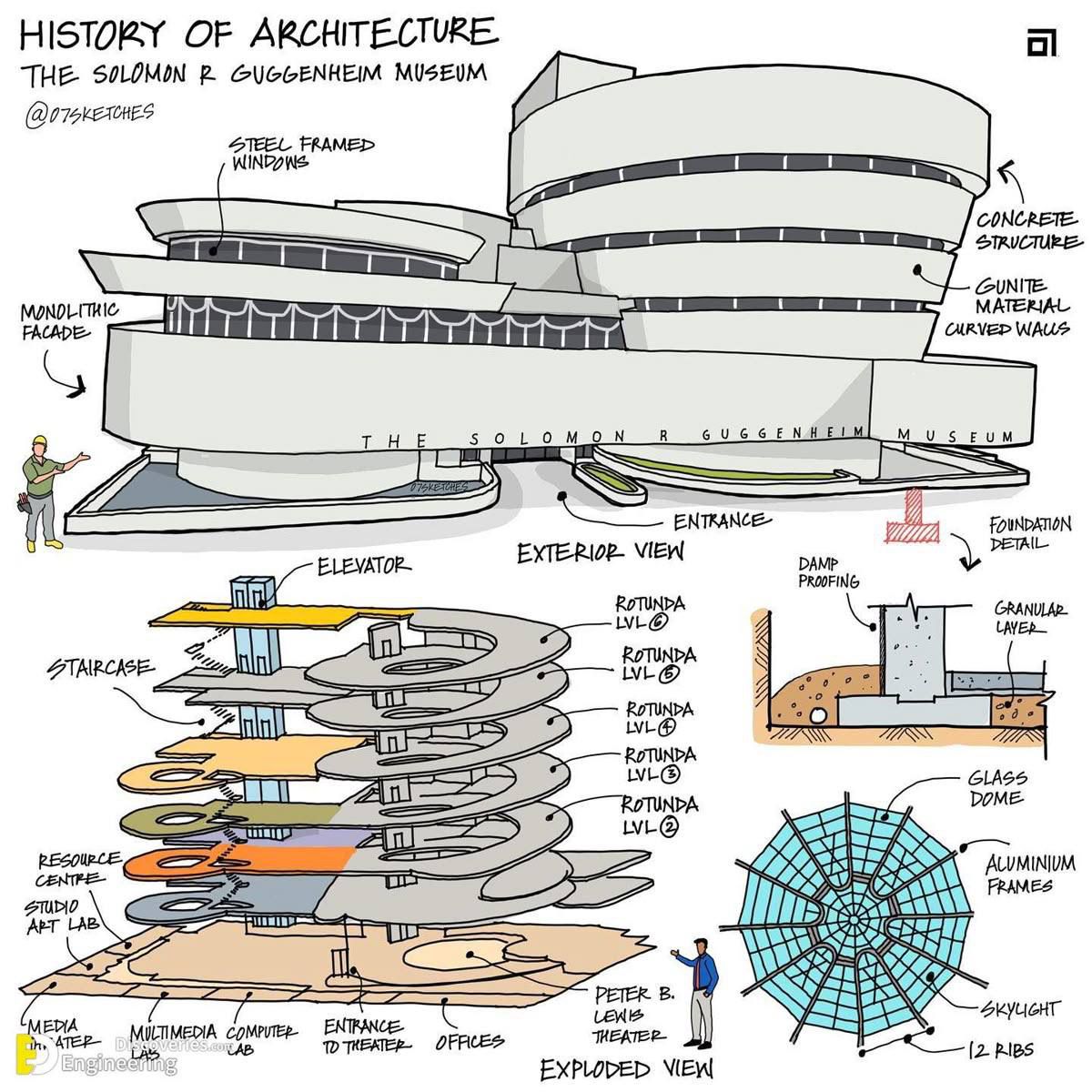The Solomon R. Guggenheim Museum in New York City is one of the most iconic modern architectural landmarks in the world. Designed by Frank Lloyd Wright and completed in 1959, the museum broke away from conventional building design with its curved, organic form. Instead of rectangular galleries, Wright envisioned a continuous ramp spiraling upwards, where art would be displayed along flowing walls bathed in natural light.
This design was radical and controversial at the time but later became a symbol of modernist architecture and organic design principles.
🔍 Key Architectural Features (Based on the Diagram)
1. Exterior View
- Monolithic Facade: The smooth, concrete facade gives the museum its iconic cylindrical look.
- Gunite Material Curved Walls: Gunite, a sprayable concrete, allowed the curved forms to be constructed with precision.
- Steel-Framed Windows: Long horizontal bands of windows bring natural light into the rotunda.
2. Structure and Foundation
- Concrete Structure: Reinforced concrete was chosen for strength and sculptural flexibility.
- Foundation Detail: Built on a granular layer with damp proofing to resist moisture.
- Circular Form: The cylindrical shape mirrors natural geometry, reflecting Wright’s philosophy of organic architecture.
3. Exploded View of the Interior
The interior layout revolves around a central rotunda:
- Rotunda Levels (0–4): The main spiraling gallery space where visitors experience art as they ascend or descend the continuous ramp.
- Elevator & Staircase: Provide vertical circulation alongside the spiraling ramp.
- Resource Centre & Studio Art Lab: Spaces for education and creativity.
- Media & Multimedia Centers: Equipped for exhibitions beyond traditional paintings and sculptures.
- Peter B. Lewis Theater: An auditorium for lectures, film screenings, and performances.
4. Glass Dome & Skylight
- The glass dome acts as the museum’s crown, bringing in natural sunlight.
- Supported by aluminium frames and 12 ribs, it distributes light evenly across the rotunda.
- This feature reinforces Wright’s belief that art should be viewed in natural light, not artificial illumination.
🌍 Architectural Significance
- Breaking Tradition: Unlike traditional box-like museums, Guggenheim’s spiral ramp encourages fluid movement and interaction with art.
- Organic Architecture: Wright designed the building as part of nature, with curves mimicking shells, spirals, and natural forms.
- Engineering Innovation: Use of gunite concrete and a skylight dome were cutting-edge at the time.
- Cultural Impact: Today, the Guggenheim isn’t just a museum—it’s a piece of art itself, drawing millions of visitors from around the world.
🏆 Legacy
Since its opening in 1959, the Solomon R. Guggenheim Museum has been recognized as a UNESCO World Heritage Site (2019) as part of the “Works of Frank Lloyd Wright”. It remains a prime example of how architecture can redefine how humans experience space and culture.
✅ So in short:
- Exterior: Smooth, curved concrete facade.
- Interior: Spiral rotunda with continuous gallery ramp.
- Crown: Glass dome skylight.
- Function: Museum + theater + education center.
- Impact: Revolutionized museum design worldwide.
